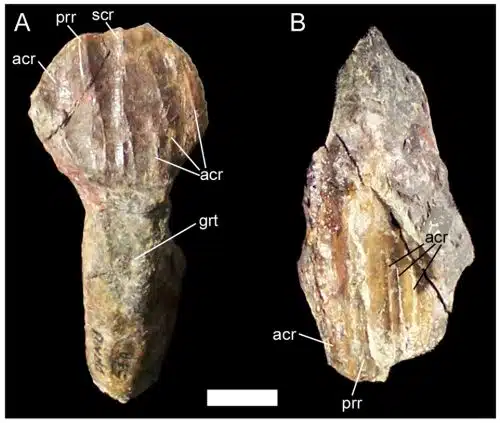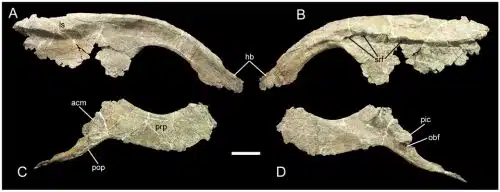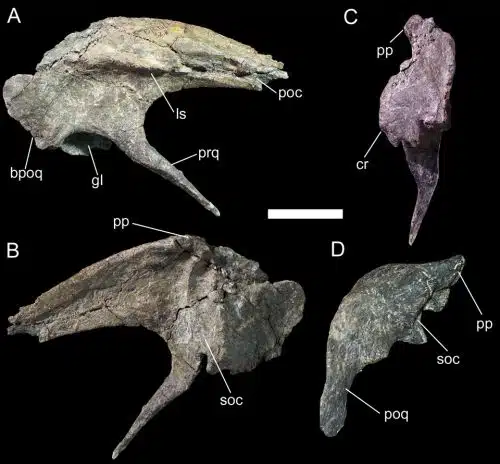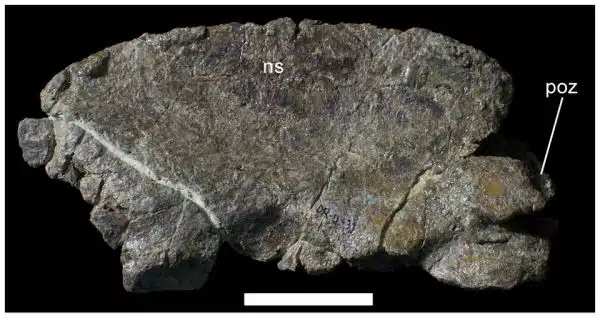Towering above the undergrowth of Early Cretaceous Utah, Iguanacolossus fortis embodied strength in both name and form. Unearthed from the Yellow Cat Member of the Cedar Mountain Formation, this robust herbivore provides a fascinating glimpse into the diversity of North America’s ancient ornithopods. Though known from a partial skeleton, its distinct anatomical traits and large size set it apart from other ornithopods of its time.
The discovery of Iguanacolossus offers insight into the evolutionary experimentation taking place among iguanodontian ornithopods before hadrosaurs rose to prominence. Its unique blend of traits adds to the growing picture of how these versatile herbivores adapted, diversified, and thrived across the dynamic landscapes of the Early Cretaceous.
Iguanacolossus Key Facts
| Keyword | Fact |
|---|---|
| Pronunciation | ih-GWAH-nuh-kuh-LOSS-us |
| Meaning of name | Colossal iguana |
| Group | Ornithopoda |
| Type Species | Iguanacolossus fortis |
| Diet | Herbivore |
| When it Lived | ~145.0 to 132 MYA |
| Period | Early Cretaceous |
| Epoch | Berriasian to Valanginian |
| Length | 30.0 feet |
| Height | 8.2 feet |
| Weight | 5.5 tons |
| Mobility | Moved on all fours |
| First Discovery | 2005 by Donald D. DeBlieux |
| Described by | 2010 by Andrew McDonald, James Kirkland, Donald DeBlieux, Scott Madsen, Jennifer Cavin, Andrew Milner, Lukas Panzarin |
| Holotype | UMNH VP 20205 |
| Location of first find | Cedar Mountain Formation, Utah |
Iguanacolossus Origins, Taxonomy and Timeline
The name Iguanacolossus is a nod to both appearance and ancestry. The genus name combines “Iguana,” referencing the resemblance between the teeth of early iguanodontians and those of modern iguanas—a similarity first noted in the 19th century when Iguanodon was named—and “colossus,” Latin for giant. The species name fortis, meaning “mighty,” completes a title that underscores the animal’s impressive size and presence in its ancient ecosystem.
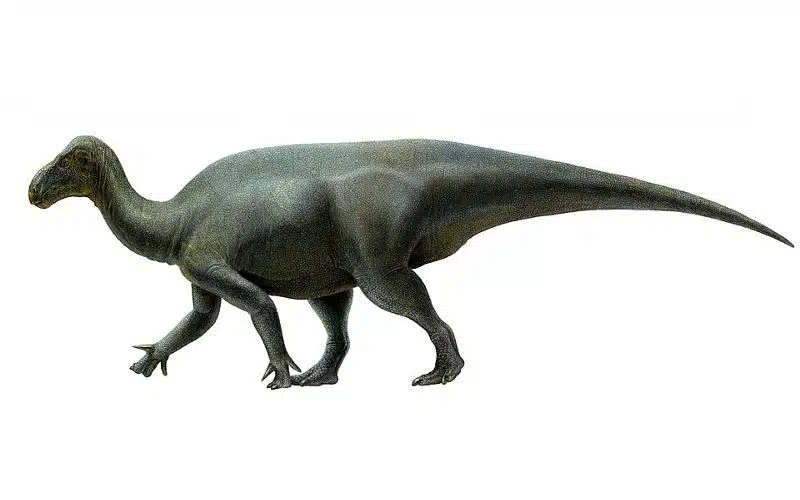
Taxonomically, Iguanacolossus is a member of Ornithopoda, a major clade of herbivorous dinosaurs within Ornithischia. More specifically, it belongs to Ankylopollexia, a derived subgroup of iguanodontians united by features such as a robust, conical thumb spike. This anatomical trait—along with other skeletal characteristics—places Iguanacolossus among a lineage that represents the evolutionary transition from more basal ornithopods to the later, more specialized hadrosaurids. The only known species, Iguanacolossus fortis, is notable for its large size and distinctive pelvic and cranial features, which help illuminate the diversity of Early Cretaceous iguanodontians in North America.
Fossils of this dinosaur were recovered from the lower Yellow Cat Member of the Cedar Mountain Formation, placing it in the Valanginian to early Barremian stages of the Early Cretaceous—approximately 139 to 125 million years ago. This temporal placement offers valuable insight into the early diversification of North American iguanodontians, highlighting a key transitional phase in ornithopod evolution when multiple distinct lineages were beginning to emerge across Laurasia.
Discovery & Fossil Evidence
The story of Iguanacolossus began at a site known as Don’s Ridge near Green River in Grand County, Utah. In 2005, Donald D. DeBlieux discovered a partial skeleton in the lower section of the Yellow Cat Member of the Cedar Mountain Formation. The specimen was catalogued as UMNH VP 20205 and is now housed at the Utah Museum of Natural History.
The recovered fossils include cranial fragments like a partial predentary, squamosals, quadrates, maxilla, and isolated teeth. Postcranial elements such as dorsal and caudal vertebrae, a scapula, parts of the pubis and ilium, metatarsals, and a fibula were also found. All elements were disarticulated but clearly from a single individual, as there was no overlap or size discrepancy between bones.
While Iguanacolossus is known from a single specimen, its preservation is detailed enough to reveal several distinctive anatomical features. Notable among these are a wavy, interlocking surface on the squamosal bone at the back of the skull and a sharp, blade-like spine on the axis vertebra near the neck. The ilium is particularly striking—its preacetabular process ends in a laterally expanded, boot-like projection, a unique modification among related taxa. Additionally, the robust proportions of the forelimbs and the structure of the vertebrae suggest a powerful, well-muscled animal. Together, these traits help paleontologists confidently separate Iguanacolossus from other iguanodontians of the Early Cretaceous.
- Teeth of UMNH VP 20205. (A) Dentary tooth of UMNH VP 20205 in lingual view.
- Pelvic elements of UMNH VP 20205. Right ilium of UMNH VP 20205
- Right squamosal of UMNH VP 20205
- Axial neural arch of UMNH VP 20205.
Iguanacolossus Size and Description
Despite being incomplete, the remains of this iguanodont offer a wealth of anatomical detail. Its structure indicates a heavy-bodied, quadrupedal herbivore with a relatively short skull and stout limbs. This was not a creature of speed but one of stability and power, built for steady foraging across prehistoric floodplains.
Short description of Iguanacolossus
Iguanacolossus was a powerfully built herbivore with a broad, flattened snout and strong jaws lined with teeth ideal for slicing through tough vegetation. Its skull featured reinforced bones and unique structural details that set it apart from its relatives. The neck and back vertebrae were robust, with prominent spines and lateral extensions suggesting strong muscle attachments.
Its limbs were sturdy and well-suited for supporting a large body, with a broad, paddle-like shoulder blade and a distinctively shaped pelvis. A long, flexible tail—supported by chevrons along its underside—would have aided in balance as this hefty dinosaur moved through its Early Cretaceous environment.
Size and Weight of Type Species
The size of Iguanacolossus fortis has been estimated at around 30 feet (9.1 meters) in total length. Shoulder height reached approximately 8.2 feet (2.5 meters), which would have allowed it to browse both low and mid-level vegetation with ease.

Weighing in at around 5.5 tons (11,000 lbs), this dinosaur was a formidable presence in its ecosystem. These numbers place it in the same size class as other large ankylopollexians like Iguanodon bernissartensis, though slightly more primitive in its skeletal features.
These estimates are based on comparisons with better-known relatives and scaled measurements of the preserved elements. The right ilium, for instance, measured nearly 90 cm in preserved length alone, hinting at a sizable and powerful frame.
The Dinosaur in Detail
Among the traits that make Iguanacolossus stand out, the architecture of its skull is especially striking. Its squamosal bone features a sinuous contact with the supraoccipital when viewed from behind—a unique twist not seen in other ankylopollexians, and one considered an autapomorphy, or evolutionary one-off.
Its vertebrae tell their own story: the axis vertebra bears a sharply defined, blade-like neural spine, more prominent than in earlier ornithopods like Camptosaurus. This likely anchored stronger neck muscles, hinting at a more powerful head and neck movement—potentially useful for foraging or defensive behavior.
Other notable skeletal features include an extended prequadrate process on the squamosal, curved pubic bones, and a broad, paddle-shaped scapula. These adaptations suggest a dinosaur built for stability and strength—an efficient, ground-dwelling herbivore well-suited to the shifting landscapes of Early Cretaceous North America.
Interesting Points about Iguanacolossus
- Its name combines “iguana” and “colossus,” referencing both its teeth and size.
- It was discovered in Utah’s Yellow Cat Member, an area rich in Early Cretaceous fossils.
- The sinuous contact on its squamosal bone is unique among known iguanodontians.
- It was first described in 2010 alongside another new dinosaur, Hippodraco scutodens.
- Though only one specimen is known, its bones are exceptionally informative.
Contemporary Dinosaurs
In the same ecosystem, a formidable theropadan predator named Utahraptor prowled the ancient woodlands, wielding sickle-shaped claws and powerful jaws lined with serrated teeth. Much larger than most of its raptor relatives, it may have hunted in groups and posed a real threat even to sizable herbivores like Iguanacolossus. Its speed and strength meant constant vigilance was essential for any prey species.
Sharing the landscape was Gastonia, a squat, heavily armored nodosaur that browsed low vegetation while relying on an array of spines and bony plates for protection. With its defensive build, Gastonia likely avoided direct confrontation, but its presence underscores the diversity of herbivorous strategies in the region.
Towering above them both was Cedarosaurus, a long-necked sauropod that roamed in search of foliage higher off the ground. While not as spiny or flamboyant as some of its relatives elsewhere, it filled the role of a massive high-browser, adding vertical depth to this layered Early Cretaceous ecosystem.
Iguanacolossus in its Natural Habitat
Picture a semi-arid floodplain laced with seasonal streams, where patches of ferns, towering conifers, and early flowering plants created a patchwork of green. This was the world of Iguanacolossus, a warm and dynamic landscape where periodic floods buried remains in silt, preserving glimpses of ancient life in exquisite detail.
As a robust herbivore, Iguanacolossus likely browsed on fibrous plants like cycads, horsetails, and low shrubs. Its powerful jaws and shearing teeth allowed it to process tough vegetation, while its sturdy limbs supported slow, steady movement across uneven ground. Though primarily quadrupedal, it may have reared on two legs to reach taller foliage.
This animal may have lived in loosely formed herds or moved in small groups. Its size alone provided protection from many carnivores, but its height and excellent field of vision could also have played a defensive role. Its heavy tail and stable stance suggest it was well-balanced and suited to life on uneven terrain.
Frequently Asked Questions
It was first discovered in 2005 by Donald D. DeBlieux in Utah’s Cedar Mountain Formation.
This dinosaur reached about 30 feet in length, 8.2 feet in height, and weighed around 5.5 tons.
As a herbivore, it consumed tough vegetation, including conifers and early flowering plants.
It lived in what is now eastern Utah, in a floodplain environment during the Early Cretaceous.
It was an ankylopollexian ornithopod, an iguanodontian close to the lineage of hadrosaurs.
So far, fossils have only been recovered from its type locality in the Yellow Cat Member.
Sources
The information in this article is based on various sources, drawing on scientific research, fossil evidence, and expert analysis. The aim is to provide a comprehensive and accurate overview of Iguanacolossus. However, please be aware that our understanding of dinosaurs and their world is constantly evolving as new discoveries are made.
This article was last fact checked: Joey Arboleda,09-05-2025
Featured Image Credit: Lukas Panzarin, CC BY 2.5, via Wikimedia Commons

